MaYday
CEREMONY AND CELEBRATION : TWO ‘OSSES - ONE TRADITION.
Throughout the world communities carry out celebrations that are special to the people in those places. They have often taken place for so long that the origins have become obscured. This is true of the Padstow May Day celebrations, which are not unique, but have retained a special character that sets them apart. The man beneath the gown wearing the fearsome mask portrays a certain menace. Another personality. A sense of magic and of time standing still electrifies the atmosphere on this day. How old is it? Pre- Christian ritual or rustic Elizabethan fundraiser? Who knows? More likely fragments of both, surviving because a community refused to let it die, emerging in the 21st century as a symbol of community spirit in an ever-changing world. Listen to the words of the song "Unite and unite and let us all unite for summer is acome unto day"
WHAT PEOPLE WEAR.
White tops and trousers once only worn by a few ex sailors have become the standard dress for both parties. The piratical look favoured by the Old ‘Oss party was introduced in the 1950’s. The wearing of spring flowers, the flags the greenery and the Maypole are all part of the May Day experience.
Cowslips have a special significance and are much in demand in the run up to the day. Once gardens were raided for tulips etc. but thankfully such anti-social behaviour is a thing of the past. (well almost!)
"With the merry ring adieu the joyful spring" the song goes and at times the ’Oss’ dies a symbolic death only to leap up with renewed vigour. Ancient Fertility Rite some say, and don’t forget it is said that if a maid is seen caught under the gown she will become pregnant before the year is out. Who can argue with such a potent image?
The "GREAT WAR" 1914-1919 was a time of change for people everywhere. In many places the old customs died with the men on the battlefield. Here in Padstow the mood of survival gave encouragement for a new ‘Oss party to emerge, based on a previous Blue Ribbon ‘Oss with a patriotic red, white and blue ribbon round the rim of the gown and on the hat. It was also called the Armistice or Peace ‘Oss. The mask of this ‘Oss was slightly different too, a beard distinguished it from the original Old ‘Oss.
THE PRESENT AND THE FUTURE.
Today the friendly rivalry between the two enthusiastic groups helps to ensure the future of this special custom. Tourists flock to witness the spectacle, but it is not for them that it continues. This is Padstow’s day and it is a tribute to both ‘Oss parties that it has essentially remained as such, in spite of this invasion.
THE MYSTERIOUS MASK
It is not known where the design for the Mask came from.
The details are carefully copied year after year, including the letters O B
that have long since lost their significance.
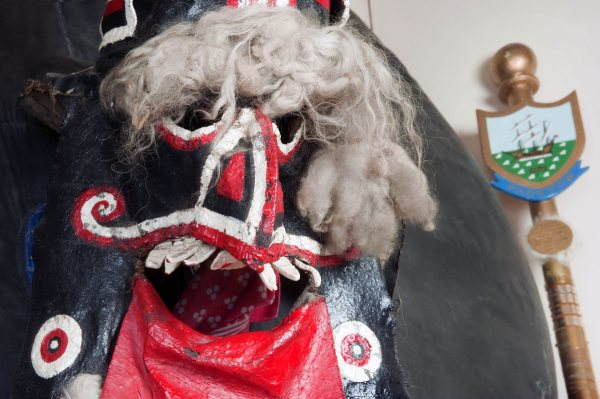
The fearsome mask, a retired version of which can be seen in the museum.
The men who built the wooden ships and the men who sailed in them have left us their legacy. Is it mere fancy to suggest that the design may have been brought back from some other part of the world, where masked figures bearing an uncanny resemblance to our ‘Oss have been recorded?
Note the dramatic use of horse hair and sheep’s wool in the design along with the snappers at the front. These were once worked from inside the ‘Oss by means of a string. The message is clear "Hand over your coin or the beast may bite". Once, these funds were vital. Nowadays the money goes to charitable causes. The night singing remains unaccompanied, a simple and almost reverential start to the proceedings after the Church clock has struck midnight. The route, mainly in the old part of town, visiting well-known residents and singing appropriate verses. This part of the proceedings is led by the Old ‘Oss Party and begins outside the Golden Lion Inn, finishing somewhere "uptown" in the early hours.
"Rise up Alec Rickard and Gold be your ring, for Summer is acome unto day’
and bright is your bride as she lays down by your side, in the merry morning of May"
"I warn you Young Men everyone, for Summer is acome unto day,
to go into the greenwood and fetch your May home, in the merry morning of May.
"Now we fare you well and bid you all good cheer, for summer is acome unto day,
we’ll call once more unto your house before another year, in the merry morning of May".
THE GOWN OR SKIRT
The use of sailcloth to make the gown or skirt has been discarded for more modern material that is both lighter and easier to manage. Tar is no longer used as blacking (for the gown) and the paint now used no longer comes off on the hand when touched, considered a potent good luck symbol in its day! Today a touch is sufficient and the Osses will seek out elderly and infirm Padstonians in order that they may do this.
Recommended reading – Demons of Disorder – Dale Cockrell – Cambridge University Press.
THE TEAZER
Dances in front of the ‘Oss taunting the beast, but ever respectful. The man or woman, boy or girl sweeps the air with graceful movements stepping nimbly about the cavorting creature.
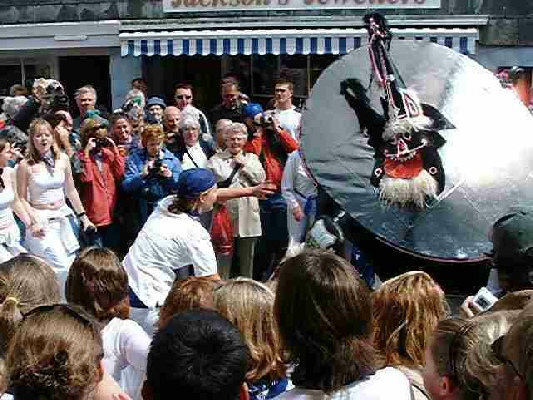
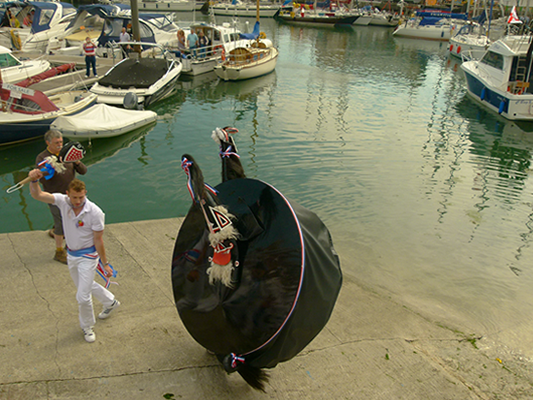
Teazer’s Club made by Ivan Constance painted by Michael Constance.
THE MUSICIANS
They are very prominent in today’s parade. Most of the homemade instruments seen in the old photos have disappeared. From the handful observed in the 1950’s we now get 20 or more accordionists and drummers in each party and numbers quite often have to be restricted.
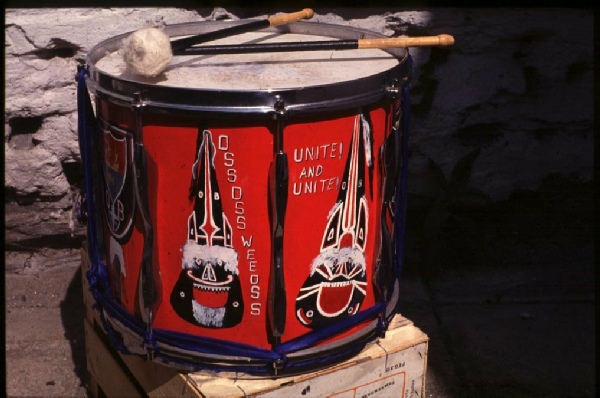
Drum as used by Old Oss Party.
Typical squeeze box used by a musician some more accomplished players have very superior instruments.
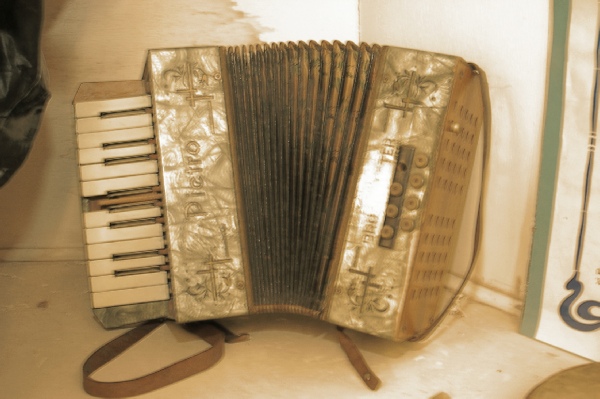
Old Melodeon played by Bluey England this instrument is well over 100 years old and is featured in many of the older photographs of the Mayday happenings.
THE MAYPOLE.
These were once common throughout Europe. In Padstow we know that one used to be erected in front of Cross House. The pebble cross was dug up each year and a decorated pole provided by the occupant, at that time the Tredwen shipbuilding family. The site itself could very well have had ritual significance but after complaints the pole was moved to its present position in Broad St where it is an impressive focal point.
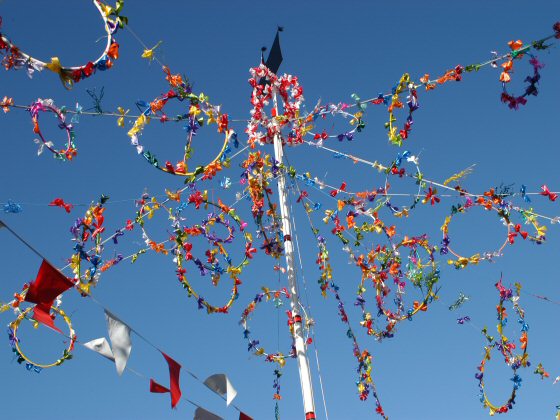
CHILDREN'S OSSES.
There seems never to have been a time when colts or junior Osses have not been a part of May Day. They start out much earlier than the main parties and usually finish before 10.30am. Their numbers and presentation may vary but the enthusiasm is undimmed.
THE PROGRAMME.
As the posters state the two Osses start the daytime proceedings at 10.00am and 11am respectively. They take different routes to each other. The Old ‘Oss visits Prideaux Place home of the Squire, in the morning moving up town in the afternoon with the Blue Ribbon Oss paying their visit in the afternoon. There are further perambulations in the evening, with occasional meetings of the two parties. A spectacle, which is much enjoyed, by the onlookers.
THE FAREWELL.
At the end of the day - sometime between 9.30 and 10 pm the Osses are stabled until the following May Day and both teams sing the very appropriate "Farewell" song - which was an Edwardian ballad about a soldier lamenting the parting from his loved one.
"I go where duty calls me,
I go what ere befalls me,
Farewell Farewell, my own true love."
In our various quotes from several 19 century sources on Padstow and May Day we have previously omitted one of the earliest observations from C.S.Gilbert’s Historical Survey of the County of Cornwall published in 1820. It is significant in that it states "the inhabitants dress up a man in a horse’s skin". This description is not the same as the one detailed in the Bible Christian Magazine just a few decades later which relates fairly closely to the scene we witness today. (See Padstow Echo reprints) We are left wondering where Mr. Gilbert got his information from. However there is no mistaking the general feel for the occasion.
The Rev Charles Prideaux-Brune was at this time the Lord of the Manor. He was the first in the Prideaux family to inherit the name Brune. Not yet finished was the mansion of Thomas Rawlings at Saunders Hill. Gilbert writes –
"The streets of Padstow are in general narrow and uneven and many of the buildings have an ancient appearance, yet the town has been greatly improved within the last thirty years by the erection of several houses, which are in general very neat. These together with the numerous gardens which line the sides of the vale, in which the whole is situated, produce when viewed from the water, a very pleasing effect.
There is an annual jubilee kept up at Padstow, on May 1st, known by the name of the Hobby Horse, in illusion to which, the inhabitants dress up a man in a horses skin, and lead him through the different streets. This odd looking animal amuses, by many whimsical exploits, the crowd which follows at his heels, particularly by taking up dirty water, wherever it is to be found, and throwing it into the mouths of his gaping companions. These tricks naturally produce shouts of laughter, and the merriments are accompanied by songs made for the occasion. The origin of this festival appears to be unknown."
Taken from, "An Historical Survey of the County of Cornwall" by C.S. Gilbert – pub 1820.
As well as the animal skin comment the "splashing" actions are interesting. Quoting from "Folklore of Cornwall" by Deane and Shaw (Tempus new edition 2003). Writing about May dew customs they say:
"The importance of dew may have had some link with the May Day practice of sprinkling with water, ‘dipping’, to bring good luck. We have already noted that the Padstow Oss once visited Treator Pool for this purpose and all over Cornwall, dipping was a common custom. In Polperro and Pelynt anyone not wearing a lucky ‘may’ blossom was dipped, while in Looe, the boys went around carrying bullock horns filled with water. They walked through the town singing.
"The first of May is Dipping Day The sixth of May is Looe Fair Day."
Dipping as we are into the comments made on May Day in years gone by we end with those of Mr. George Rawlings who wrote to Robert Hunt the author of "Romances of the West of England" on Sept 1st 1865.
"Formerly all the respectable people kept the anniversary decorated with the choicest flowers but some unlucky day a number of rough characters from a distance joined it, and committed some sad assaults on old and young – spoiling all their nice summer clothes, and covering their faces and persons with smut. From that time – fifty years since – the procession is formed of the lowest. The maypole was once decorated with the best flowers – now with only some elm branches and furze in blossom. The horse is formed as follows :- The dress is made of sailcloth painted black – a fierce mask – eyes red – horse’s head – horse hair mane and tail distended by a hoop. Some would call it very frightful. Carried by a powerful man – they could inflict much mischief with the snappers. No doubt it is a remnant of the ancient plays, and it represents the devil, or the power of darkness. They commence singing at sunrise". Padstow Echo No 110 May 1999.
"The people have long been in the habit of singularly dressing up some strong man on the first of May, and following him with noisy mirth"
Nothing new or startling with this statement, as we come round once again to this day of days for all Padstow people. Much has been written on the whys and wherefores of this ancient custom of ours and the story of when Thomas Tregaskis the Bible Christian miller tried to stop May Day has been quoted many times. His objections were not against revelry as such; otherwise why offer an Ox to be roasted for at least a seven-year period at considerable personal expense, but to that aspect that he saw promoted drunkenness. He had his supporters then and I suspect there are those today who would support his sentiments. He died in 1873, twenty-eight years after the Ox incident and we have from a memoir printed in the Bible Christian Magazine at that time a description of the day. The writer I feel was not totally disapproving of the event that he describes in such detail.
"There is the "gown" to begin with, made of canvas or some coarse material of the kind, painted black, caused to swell out to its proper dimensions by an enormous hoop at the waist, from which it tapers up to the neck; then the conical headpiece, answering the two-fold purpose of hat and mask, having a mixture of red and black, with a tuft of horse hair at the top. Attached to the hoop behind is a great sweeping tail and in front the "snappers" with iron teeth, and hair hanging down from it goat fashion; it is made to "snap" at the pleasure of the man inside, who holds a string in his hand, slackening which the under jaw drops with its own weight and a twick brings it up with a sharp sound to the upper-jaw. A great part of the fun consists in the man who carries the dress running after people making as if he would snap at them, or lift the gown over their heads."
"The opinion which prevails among the more intelligent is that it is a relic of druidism, and verily it is worthy to have descended from the days of barbarism"
MAY DAY IS NOT LIKE IT WAS YEARS AGO
"On the evening of April 30th, it might be seen that the town was all astir; for strong young men from the different yards were bringing up the "maypole"; adorning it with furze erecting it and making it sure with ropes, for the great events of the night. May morning comes, and at a given hour in the forenoon hundreds of young and old are at the windows, watching for a glimpse of the Hobby Horse. The eye of expectation was turned towards the Public House at the bottom of the central street. Here he comes! Crowds outside saluting him with loud cheering and firing of pistols over his head, loaded of course with powder only. There is dancing too and singing of "May Songs" Out into the country first thing, the air rending with frantic noises. Perambulating the town in the afternoon, getting up money, eating and drinking during the day, as they may. Now may be seen the special appendage of "smutting" - powder made into paste spread on the palm of the hand, then rubbed into anybody’s face, the clearer and fairer the face the greater the fun. Sometimes in place of Powder paste Lamp Black is used. The day finishes up with dancing, drunkenness, fighting &c. It is as if the Hobby Horse were Bacchus with his many worshippers."The writer obviously knew his May Day; I leave it to the reader to seek out the differences with the present day. The full text can be read in the Courtney Library at Truro Museum in the Bible Christian Magazine for 1873 (pages 309/10) or ask me for a copy. APRIL 30th 1896
May Day is close upon us but very little heard as yet of the May Song. How different this from twenty years ago. In those days the strains of the old song were heard nightly from March to September. The custom of keeping up the "hobby hoss" is gradually dying out and in a few years will be little else than a recollection with old people.
The reporter’s pessimism continues in his later report, but he does end on a more positive note, I quote.
MAY 7th 1896
The "Hobby Hoss" demonstration invariably held on May Day passed off very quietly. The weather was very fair but the followers of the "Hoss" were less numerous than usual, although if reports be true the "collection" which they always devote strict attention produced a good round sum. There was very little damage to the flower gardens thanks partly to the alertness of Sgt Hugo and those under him. It is however evident that the "Hobby Hoss" demonstration is gradually dying out and will soon cease altogether. To strangers to the town the whole affair seems absurd, and one gentleman at a public meeting expressed his disapproval of it in vigorous terms; but there was not much in the conduct of those responsible for the demonstration that any person could reasonably complain of. Eighteen years earlier this enthusiasm among the local people for May Day caused the Headmaster of the Board School to record in his Log Book.
The influence of Bank Holidays has hardly reached this remote place… On the other hand May Day in Padstow when almost every other City, Town and Village is in its usual working order is a season of rejoicing amongst the lower classes of a kind beyond ridiculous.
"These words from over a hundred years ago send their own message to the present day custodians of the "Obby Oss" tradition. I’m sure our sympathetic reporter of the past along with "Boss" Harding the Headmaster for the "new" (1876) school’s first seventeen years, would be truly amazed at the way things are today.
News reports taken from copies held in the Courtney Library Truro Museum, Headmasters Log Book, Padstow School, available for inspection by appointment at County Record Office, Truro.
MAY DAY MYSTERY
Extracts from the PADSTOW ECHO Issue 113 May 2000
Another May Day has arrived. Shaped by countless generations of Padstonians from time "immemorial". Where did it all come from? What is it all about? You could say "just enjoy it me ansum" and be right. Does it really matter? The important thing is to "keep er gain". Part of the magic of this day lies in the fact that after centuries of adaptation it’s origins have become obscure. This has fuelled the curiosity of locals and visitors for many years you can read about it in Donald Rawe’s excellent book "PADSTOW’S OBBY OSS" or in Ronald Hutton’s "THE STATIONS OF THE SUN" a wider drawn account of the many Calendar Customs in Britain.
From the early times of the Victorian "Folklore" collector comparisons have been made with similar customs involving ritual and masked figures in other countries and here are three examples.
The first was noted in 1912 by Thurstan Peter an eminent Cornish Historian who was struck by the similarities in appearance with the "Duk Duk" in New Guinea. My recent enquiries have unearthed details of village theatre in the Eastern Highlands (National Geographic) that is very much alive and I have hopes to track down the "Duk Duk" sometime. Also from this source came details of a custom in LIBERIA where "An animated Hay Stack with ebony head dances to the throb of drums. It drives away evil spirits" the reporter was warned not to go too close. Thanks to my friends in the Strand Book Shop I obtained an old copy of the "Cornishman" magazine containing an article by Mary Utton describing a Dance held in Mexico called "SHALAKO" (Yes there was a movie, Sean Connery, Bridgett Bardot!!) the author had seen our "Oss" and was struck by the similarities. As in New Guinea there were strong elements of initiation and fertility in the ceremony. "The central figure was decorated with a feathered head-dress, while a tent like garment covers the dancer. The mask also has a wooden "beak" which the dancer snaps open and shut at certain points in the dance. Accompanying the "Shalako" was a side dancer. Together the two dancers stamped out the measured steps of the dance. The songs changed but the dance was always the same, and was to continue for six hours without respite. As a religious ceremony it was impressive; and as a physical feat of endurance it was no less so. Great reverence and awe was noticeable, especially on the part of the older Indians, while the children were frankly terrified and often hid beneath their mothers skirts." What do these glimpses tell us? Perhaps nothing more than the fact that, in so many ways, people from other races and cultures, are not so different from us. This yearning to understand and identify our "place" in life unites us all. If you feel that special feeling on the day, you will know what I mean. A hooden "horse" called "Hob nob" once accompanied a giant figure in parades at Salisbury Wilts. He can be seen in the City Museum there.
RITUAL ANIMAL DISGUISE
We should not be surprised at the amount of stuff written about May Day over the years. One book written 23 years ago by E.C. Cawte recently came to my notice called RITUAL ANIMAL DISGUISE it puts Hobby Horses into the context of other similar customs, sensibly urging readers to go to the original sources so that they make their own judgements urging that they read this book with care so that they do not misinterpret it. Sound advice indeed. A fascinating study. Get it out from the Library it’s no longer in print. JB.
At the end of Chapter X the author makes some interesting comments on SEASONS OF PERFORMANCE
"The structure of the Padstow ceremony suggests that a May ceremony of a typical kind has had a horse attached to it, so that the Padstow Horse may, at one time, have had a different time of performance which could have been Christmas, like the Penzance horse, the only other one known in Cornwall. (Edmonds 1858 concerning guise dancers). Similarly the structure of the Coombe Martin ceremony suggests that the horse and fool represent a separate performance. There is nothing in the Minehead performance to suggest that it has ever taken place at a season other than May. However, the vast majority of horses appear at about Christmas, the Penzance horse certainly did, and it seems possible, no more, that these horses may all at one time have appeared at Christmas. Certainly the designs and ceremonies of these horses are unusual, and they must surely represent local adaptations of customs acquired from elsewhere."
The Blue Ribbon Ceremonial Staff - List of Master of Ceremonies
Padstow Blue Ribbon Ceremonial Staff Presented by Hawke 1948
1948 F. Bray
1949 H. Lobb
1950 J. Rounsefell
1951 W. England
1952 T.H. Williams
1953 DR Sleeman & Mrs J. Lobb
1954 Mrs F. Magor
1955 W. Thomas
1956 J. Worden
1957 Mrs D. Farquar
1958 E. R. Thomas
1959 C. Thomas
1960 C. Jacobs
1961 C. Pinch
1962 P. Porter
1963 A. Ballard
1964 Mrs B. Grubb
1965 E. England
1966 S. Harris
1967 D. Farquar
1968 B. Bray & Mrs R. Thomas
1969 K. Chapman
1970 S. Porter
1971 M.J .Martyn
1972 D. Bray
1973 F. Lawrence
1974 Mrs N. Rickard
1975 W. Harris
1976 P. O` Keefe
1977 D. Martyn
1978 G. Lobb
1979 F. Sluman
1980 T.R. Reveley
1981 T. Magor
1982 E. Murt
1983 J. Pepler
1984 T. Thomas
1985 J. Harris
1986 G. Constance
1987 L. Kenderdine
1988 J.C . Murt
1989 A.R. Honey
1990 R.W. Martyn
1991 C.P. Chapman
1992 T. Flanagan
1993 R. Delf
A, Murt
1994 P.L .Lobb
1995 P. Jermym
1996 M.J. Masters
1997 P. Mullan
1998 R.P.J. Gool & D.J.G. Lampshire
1999 R.O` Hagan
Books on Cornwall and Padstow will most times mention May Day.
It is hoped to include a list of them elsewhere on this Museum web site.
Mapoles Madness and Mayhem.
Cooper and Sullivan- (Bloomsbury)
The Hobby Horse – Thurstan Peter (RIC)
Doc Rowe – Padstow Echo
(Special) Some books to read:
Padstow’s Obby Oss. Donald Rawe, Lodenek Press
Stations of the Sun
– Ronald Hutton (Oxford)
Ritual Animal Disguise – E. W. Cawle (Folklore Soc)
Unite and Unite Mike
O’Connor – (Lyngham House)
The Customs and Celebrations of Britain – Charles Kightly
The Hobby
Horse: An Enigma, Kelvin Jones – (Oakmagic)
West Country Hobby Horses. Herbert W Kille
(Oakmagic)
The Cornish Obby Oss (Oakmagic Publications)
Check out the Blue Ribbon “Obby Oss
Website *********
This material has appeared in various issues of the Padstow Echo, a long standing
non profit making, community magazine, which has at its core a celebration of all that makes Padstow
special to residents, exhiles and those who have just come to love the place, They form some of the May
Day related information gathered for Padstow Museum over the past few years.
Reproduced here to help
in an understanding of our heritage
Padstow Echo is no longer being printed.
